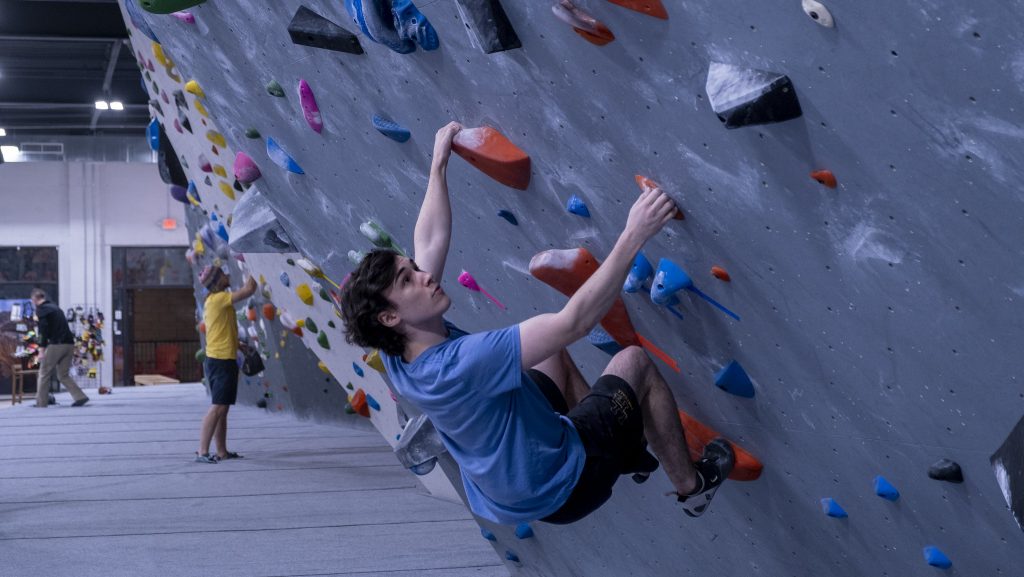Climbing jargon you need to know will start with learning what “beta” means. “Beta” is essentially the “How To” of rock climbing. Have you ever been at the climbing gym and watched other climbers make weird hand movements in the air like they’re conducting an invisible orchestra? They’re visualizing the body movements they must use to climb a route successfully. That includes figuring out the handholds, the foot placements, and the body positioning. That is beta.
Origins of Beta
Why “beta”?
“Beta” originates back to Jack Mileski, a prominent rock climber in the 80s and 90s. Mileski would videotape himself climbing using a video cassette recording format known as Betamax. (The VHS format soon overtook this). Mileski would share these tapes of himself climbing with his friends. The term “beta” quickly became the go-to slang for the how-to in climbing.

Types of Beta
Visual – Remember the climbers conducting an orchestra? That is visual beta. By practicing the movements off the wall, you reinforce them in your brains. You can spend less energy while on the wall because you already know how you want to move through a sequence.
Verbal – Verbal beta is used when discussing moves with other climbers or when somebody is helping guide a climber to the correct sequence during a climb. An example could be your belayer or spotter telling you, “Don’t forget that right foothold” or, “Remember, hips in!”
Unsolicited – Anything unsolicited is usually regarded as unwanted, and nobody wants to be undesirable. Another term for unsolicited beta is “spray.” Spraying refers to giving beta to a climber when they didn’t ask. Do not do this.
Ethics of Beta
That is quite simple: Always ask a climber if they want beta before you offer any tips. Part of the fun of climbing is figuring out how to climb a route alone; don’t take that away from anybody!
Other Uses of Beta
Beta has transformed over the years, though, and doesn’t specifically relate to the moves of a climb anymore. While this term is still used for how to move your body up a wall, beta has become an umbrella term for many things climbing-related.
Here are a few examples of how “beta” can be used when not referring to climbing movements.
- You’re going bouldering outdoors and hear, “What’s the beta on pads?” This likely means, “How many crash pads do I need?”
- Maybe you’re taking a backcountry trip to climb the mountains and wondering, “What’s the beta on base camp?” That can mean, “Where’s the best spot for basecamp?”
- Beta can even be used when discussing mundane things like, “What’s the coffee beta?” Which could mean, “What coffee grounds to water ratio should I use?” or “Where can I find some good coffee?”
These are out of the box, and even though they are rarely used, you may meet climbers who use beta this way!
The Language of Beta
As a new climber, you’re learning the beta for climbing terms. Here is climbing jargon that can assist you in giving proper beta (when welcomed, of course)
Handholds
Jug: Big holds, in-cut so you can curl your fingers when grabbing.
Crimp: Tiny holds where usually just the first or second digit of your finger can fit.
Pinch: This is what it sounds like. A hold that you can pinch.
Sloper: Rounded; these require friction and body positioning to use effectively.
Pocket: Usually described as a two-finger or three-finger in-cut hold.
Mono: Single finger pocket.
Ledge: A ledge.
Bucket: A large, scooped hold.
Hueco: Water depressions in the rock.
Footholds
Toeing: Using just the toe of your foot to stand on a hold.
Smearing: Think of pasting your foot on the wall without a foothold.
Heel Hook: Using your heel to keep balance or propel you upwards.
Toe Hook: Using your toe, usually to keep balance.
Stacking: When you have one foot on top of a hold and the other toe-hooking underneath. It is used to keep you close to the wall on an overhang.
Some more helpful climbing jargon when talking about beta is:
Hand-foot match: Using your hand and foot on the same hold.
Dynamic Climbing: Dynamic climbing is moving your body in a swinging motion, often letting go of a hold before you can grab the next one.
Dyno: Physically jumping to reach the next hold.
Static Climbing: Keeping your limbs on the wall and reaching for each hold (not jumping).
Belayer: The person on the controls the slack to the roped climber.
Spotting: Used when bouldering, a “spotter” is the spectator who actively ensures the climber falls safely and lands on the crashpad.
(Spoons, not forks! Keep your thumbs in when spotting)
Slab: A wall that leans forward.
Vertical: A directly vertical wall.
Overhung: A wall that leans toward the climber.

Recent Comments